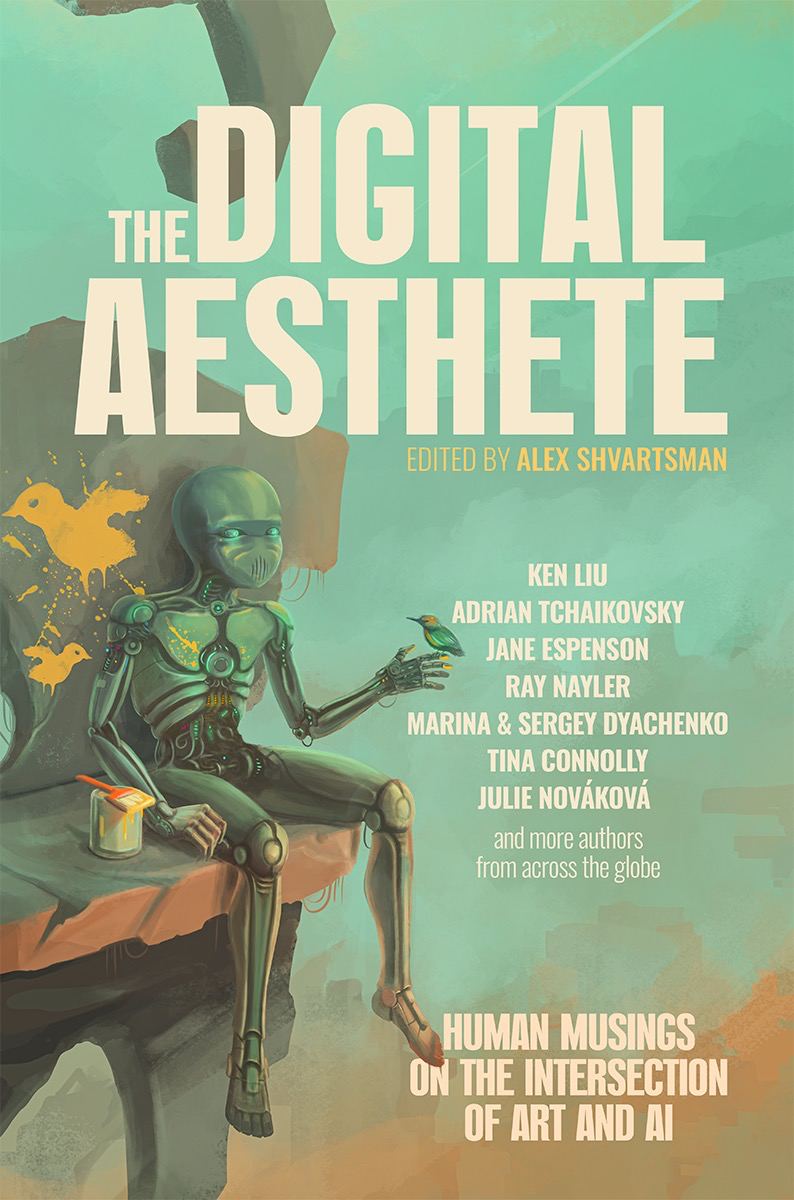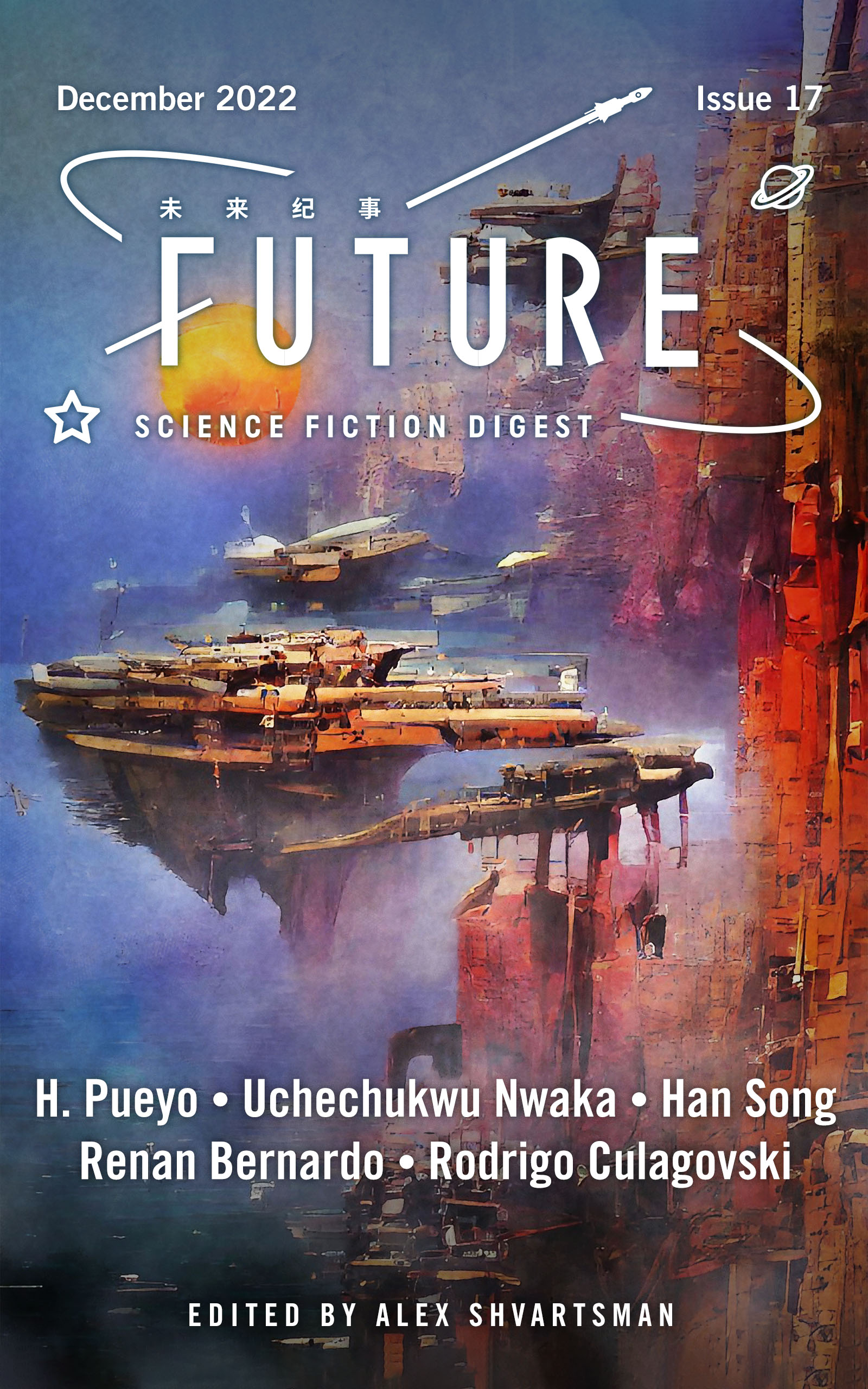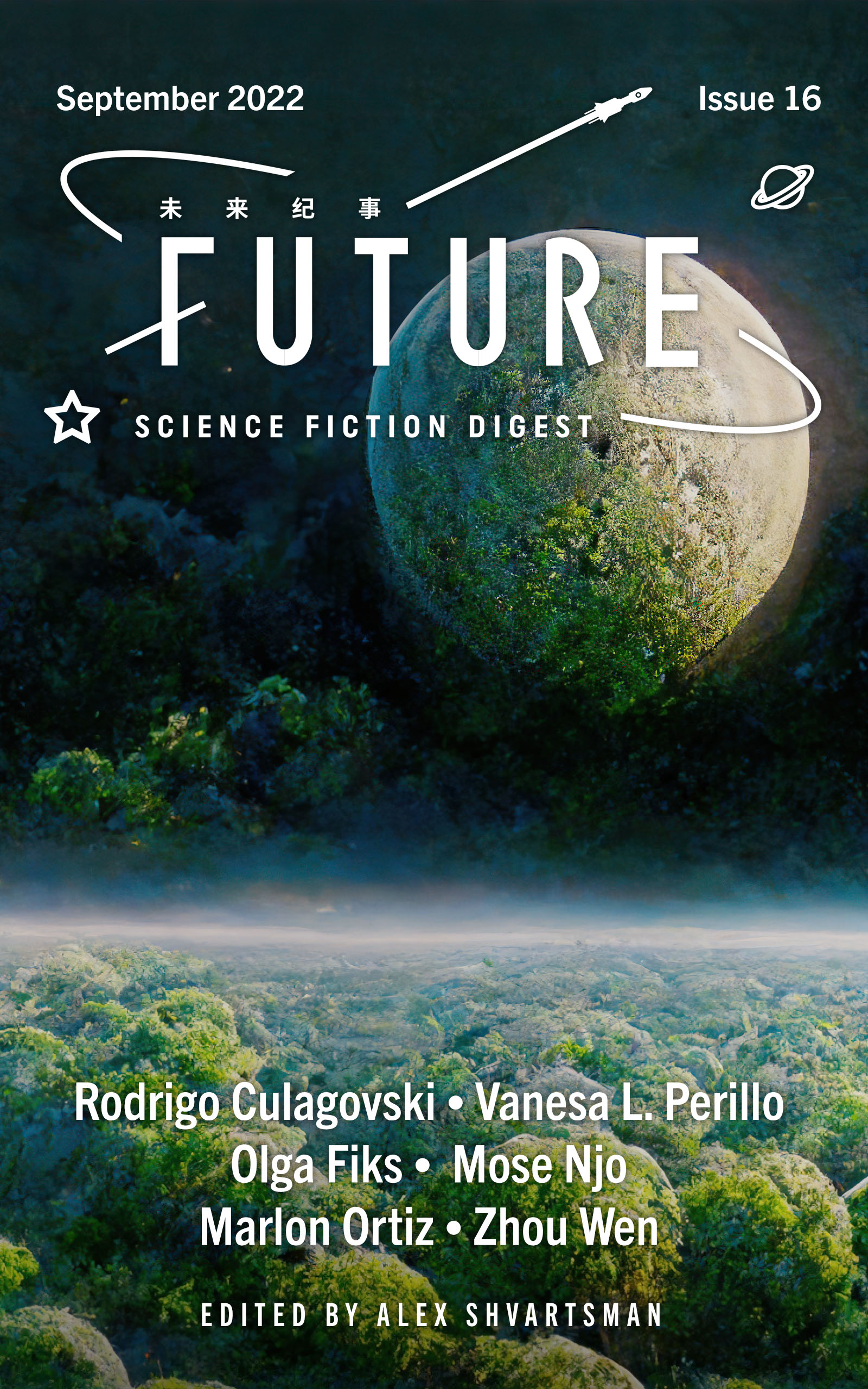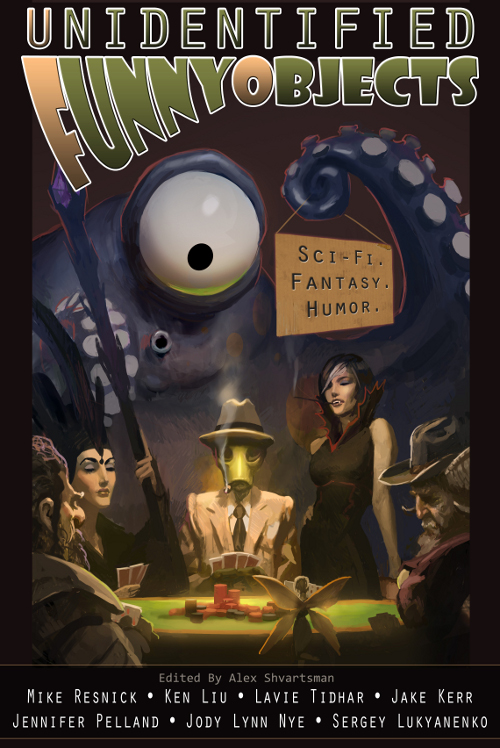What do we know about Sandoval?
Everything is communication.
In an information-rich society Sandoval was that outlier, a rebel without a node.
Earthrise:
Imagine the grey chalk surface of the moon spreading before you. You may be watching it from inside one of the cities – perhaps even Lunar Port itself, that oldest and least imaginative of settlements. Most of the cities are underground, deep shafts connecting levels upon levels of housing, shops, factories, drone-zones, waste-disposal oceans, recreational facilities and laboratories. But above all the levels is the Surface, surrounded and protected by a fragile looking dome. Inside the dome are parks and shops and villas. If you live on levels two or three you might journey in the giant elevators, once a week, to reach the surface, and walk in the almost-open air, and shop in the exclusive boutiques and pass the numerous hotels.
But if you were born on the moon you are probably unimpressed by such things, regarding the surface as a place for tourists and poseurs, and seldom go there.
Or assume you are a tourist. Then you stay at Madame Chong’s – if you have the money – right there on Armstrong Boulevard. Or you might stay at the Dojo, or in that row of cheap hotels towards the western side of the bubble, called the Gagarin Lot.
Whichever.
The hotel has all the facilities you need. Your accommodation covers air tax, water, and the rest of the municipality charges. The hotel provides you with direct access to Lunar Hub, and through there (eight light-seconds away! An eternity in data-time!) to one of the Earth Hubs. Beyond Earth-Lunar Space, beyond the habitats and ships, data-time stretches even further, communication becomes a ping-pong of replies – beyond the Belt, to distant Mars, from there on to the Outer System, for all intents and purposes a solar system in and of itself. They do things differently, there, in the outer system, in the light of gas giants, where the sun is distant and cold. They have their own networks there.
Let’s say you’re a tourist from Mars – from Tong Yun, or the kibbutzim, or the Red Soviet. You’re staying not on Armstrong but maybe down one of the side-streets, maybe on Michael Collins Way, a modest hotel in a modest part of town. No tourist ever stays below the ground, in the real city. For tourists, the moon is all surface.
Let’s say you stay at the Libra. They say Sandoval worked there, as a porter, in the early days. The proprietor of the Libra is Lunar-Japanese, third-generation, a distant descendent of Naoko Yamazaki, whose picture, in the old orange astronaut suit, dominates the interior design of the hotel.
The hotel can arrange surface trips, of course. It is exciting!
More for Earth folks, admittedly, than for the Martians, who see nothing very much of note in that lifeless grey surface, a far cry from their own red sands, on that planet where the ice-comets come crashing down into the sands, aimed and fired from orbit. For one day Mars will breathe, one day the domes would come down…
But the Earth folks love it. The tourists gather at Gate Six, get suited up. They pass the airlock. They ride moon buggies or a bus, or moon jeeps, depending on the tour package.
They come, most of all, they come to watch the Earthrise.
Picture Earthrise, then. The way Sandoval watched it, as often as he could, the image he had been obsessed with, consumed by, the image that defines him to us, for we know so little else about the man.
This is not William Anders’ Earthrise, the one seen from orbit (for that, one goes to the famed Observatory, or another such grand Lunar orbit hotel), but a slow rising of the Earth over the moon’s horizon. On the moon, Earthrise lasts for days.
Imagine that blue-white world, that living world rising, slowly, oh, so slowly over the grey horizon! Yet it does not dominate the sky, it is not large, it is the size of a marble, the size of a… moon.
The old astronauts, the Earth orbit astronauts, those who never left orbit, never accelerated away from the planet, saw it differently. They saw earth dominating the sky, filling it up. Earth was the center of the universe, seen that way. Sun and moon and stars and galaxies revolved around that single living breathing giant world…
It was only the first twelve insane moon-walkers who saw Earth for what it truly was, a tiny fleck of beautiful blue-white life, hovering in space, surrounded by darkness…
Sandoval the artist.
At the age of thirteen, they say, he tore out his node. He went to one of the clinics on Level Three (he was Lunar Port, born and bred) and paid to have it hacked out, a dangerous, insane procedure, akin to blinding one’s self.
Yet he did it. He disconnected himself from what we call the Conversation: that constant hum and buzz and drone of human voices (and machines, of course), that ceaseless exchange of information, what the Spiders, those Other-powered probes whose job it is to extend it, indefinitely, across human space and beyond, call the Music of the Spheres.
Sandoval, in his first act of rebellion, tore it out. Moreover, though we should have had, at the very least, plenty of information about him before that event, nevertheless we don’t. He had paid a viral artist (the famed Ezekiel Sándor), and the artist, Other-bonded, had created the Sandoval Worm, an exquisite piece of art that, over decades, patiently burrowed and erased nearly every trace of Sandoval’s existence from the Conversation.
All that we have of him is his work.
It is impossible to quite explain Sandoval’s work. You have to experience it. Which is not an easy thing…
They have one of his installations at the Tong Yun Museum of Fine Arts, on Mars, and another on Earth, in Newer Delhi, and one, it’s rumored, even on Ganymede, in the Galilean Republics of the Outer System.
This is what we know of Sandoval:
He was born and raised in Lunar Port, the youngest child of a line-family which broke up when he was six or seven –
Leaving him with his biological mother and one of the remaining husbands, a Gorean believer –
The young Sandoval left home at ten and never made contact again with any of his parents –
He worked at the Libra as a porter for a time –
At thirteen he had had his node removed –
They say, while working at the Libra, he had met the artist Rohini.
Rohini. Beyond the shore of Sri Lanka one can still see Rohini’s most famous artwork, Whale Suspended in Storm, with Icicles. Rohini, the weather hacker, the bomb-maker – they had attributed the notorious Jakarta Bomb to her, the single nano-factory seed planted in the heart of the city, growing, exploding – years later – into a beautiful and terrifying terrorartist attack that had transformed the city, in a few short hours, into an immense sculpture, reaching for, transforming and preserving millions of humans, cars, trees, shopping malls, birds, bicycles, markets, ants, mosquitoes, durian, metal, plastic, earth and weather into something alien and startling –
The progression of the terroartist offensive had been halted, frozen. Jakarta still sits, on the island of Java, surrounded by invisible security, isolated from its environment –
A picture of Jakarta:
A pile up of cars outside Pondok Indah Mall rises into the air, humans exploding out of it in a frozen dance, arms reaching out for the skies, hovering in the air, so clearly one can still see beads of moisture on their brows, a frozen explosion of fire caught in a crystalline cloud, a gaggle of children hovering in the air above it like angels, playing with a coconut –
Jakarta:
A giant fly, the size of a truck, angled at forty five degrees, like a missile –
Ridden by a woman sprouting horns from her forehead, a dragon-rider in jeans, the molecules of her perfume captured perfectly in a cloud around her –
Jakarta:
In M-Block the windows of a gentlemen’s club explode outwards in a frozen shower, a businessman in a dark conservative suit is cut in half, his heart, still connected, pulled out, frozen in the act of beating, a deep sound that never quite starts or stops and fills the room, the dancers, girls, hovering just above the ground, their eyes still, somehow, impossibly seeing –
How Sandoval met Rohini is impossible to say for sure. Had she truly come to Lunar Port? After the Jakarta Bomb she had disappeared, changed her appearance, gender, ident tag… they say she had been copied by the Others, the physical copy destroyed, that she lives on in one of the Others’ networked hives…
Other stories claim she escaped to Jettisoned, that lawless, distant place on Charon, there to write poems none of which exceeded five lines…
Whatever the truth of it, it is said Sandoval met her.
There is a classic Phobos Studios production called Lunar Explosion!Which tells the story of that meeting, in fictional terms. Rohini is played by Sivan Shoshanim, while Sandoval is played by a youthful clone of Elvis Mandela, the eternal star of those orbiting studios.
The production is quite melodramatic, in the style of the Second Takashima: it involves various spy agencies in pursuit of the elusive terrorartist on the one hand, and a line-family drama on the other, trying to capture Sandoval’s personality, his obsession with Earthrise, the peculiar circumstances that led him to having his node removed.
One scene takes place outside Rohini’s hotel room. Sandoval knocks on the door – a physical act shocking to us by its very being, but of course he can no longer broadcast. Rohini opens the door. Sivan Shoshanim (human or Other, we’ve never been able to establish) plays her as a young woman with an old mind, a rebel who had turned her own connectivity into an assault on society – the very opposite of Sandoval. The two leads sizzle together. Shoshanim opens the door dressed in a grey jumpsuit. She surveys Sandoval before stepping outside and closing the door.
“I’ve infected the hotel,” she tells him, “with a new work. We should leave.”
Sandoval doesn’t speak. Elvis Mandela plays him throughout as a near-mute, a young man whose internal world is deeply sealed from the viewers. Around them the walls stop projecting bland wallness and begin displaying strange and disturbing images as of an alien visual feed. A Venusian Flytrap plant in the corner hiccups and begins blowing soap bubbles. The hotel shakes, gently, as if attempting to wake up its occupants.
“Let’s go,” Rohini says.
In the next scene we encounter Rohini and Sandoval on Level Two of Lunar Port. Here, at the heart of suburbia, they are found, chased. They run into a vast laundry facility. Giant machines spin thousands of items of clothing. They tower over our protagonists, immense, the size of buildings. Rohini grins as her terrorartist node broadcasts new subversions and perversions, and the machines begin to spin clock-wise and anti-clock-wise and some open behind them as they run, spewing out multi-color garments reprogrammed to attack their pursuers. An admiral’s suit, followed by trench-coats, shorts, skirts and blouses, attacks the pursuing humans viciously, drowning them in the recycled soap water fast-flooding the room.
Sandoval and Rohini run. Through service tunnels, up a level, pursued again as they are spotted outside a Gorean temple, evade capture through a games-world arcade where Rohini initiates a singularity inside the Guilds of Ashkelon universe, Ubicking the players (an offence punishable by nodal imprisonment and/or physical incarceration), onward through a Church of Robot enclave where metal-heads stare after them in Zen Mode, and upwards, through a hydroponics flowers market, up a service elevator, and to the surface of Lunar Port again.
“The surface,” Rohini says. Sandoval says, “What?”
“We need to get out of the dome.”
“There is nothing outside the dome.”
Rohini smiles. Sivan Shoshanim’s eternally youthful face reveals so much at that moment – the ancient mind behind the physical façade, telling us, and telling Sandoval, the universe is not Newtonian – it is Bohrian.
He follows her.
Rohini overpowers the airlock interface – they steal a moon buggy – go for a wild ride along the lunar surface, grey and lifeless (but oh! The canals deep underground!).
They are chased, by the not-so-secret agents of Earth and the Red Soviet and the Malaysian corporations of the belt and the agents of the Galilean Republics and Dragon’s World and Jettisoned…
Who arrive, too late, to find Sandoval standing alone on the lunar surface, the buggy crashed a short way away, and no sign of Rohini, and Sandoval never speaks, he raises a mute face at the lens and the faceplate of his helmet reflects Earthrise, and so do his eyes…
They try to overpower him. He lets them. We fade to sensory blackout.
Of course, it did not happen that way at all.
There is no historical record of that meeting. It is apocryphal. But look.
Visit the Tong Yun Museum of Fine Arts, or take the long trip to the Outer System, or visit Lunar Port.
Experience one of Sandoval’s few remaining installations.
He had stolen, or was given, or had rediscovered from first principles, some of Rohini’s tech. There was a rumor he corresponded, for years afterwards, with a secure address in Jettisoned, that lawless world of wildtech.
Art is a crime. Crime, according to Rohini, was art. Sandoval’s first crime – the reason most of the installations were later destroyed, the reason he himself was forced, or made to, disappear – was the Other cloning of the deceased human astronaut William Anders.
Digitizing a simulacra of a living human entity is one thing, though it tends to lead to disaster . Simulating an expired human bioware without permission is an infringement not only of the Rights of the Dead Trans-Solar Act but is subject to various human-Other agreements and treaties regulating physical/digital spaces – or, in the words of Shirkan Goodbye (the actor who usually played villains in Phobos Studios productions), in his role in another depiction of Sandoval – in Lunar Mindworms II, in fact: “You’re entering a sand-sea of trouble, there, Lunar boy!”
But we digress.
Sandoval’s first crime had been to simulate a dead astronaut. Go into the wildtech jungle of Jettisoned and you might experience it – Anders floating in the tiny space module, Earthrise coming into being beyond the thin windows of the space tin – the mind of the Anders simulacra a fractal cloud of conflicting emotions –
Joined in, as Sandoval compounded his initial crime, by the minds of Anders’ companions, Borman and Lovell –
Mixed in, as Sandoval grew bold, with the slow vision of Earthrise from the surface, as experienced by the stolen minds of the first Chinese mission –
As experienced by the early settlers, by those dying on the surface, Earthrise the last thing they saw –
By couples and triples making love under the transparent domes, or in the Peaks of Eternal Light, those rare and valued places on the Lunar surface that experienced never-ending sunlight –
Sandoval became – not a body – but a mind thief. Disconnected from the Conversation he nevertheless plundered and stole, assembling and dissembling, creating quantum vistas of human probabilities centered around that single image that so obsessed him, the slow rising of Earth over moon.
His choice of subject has been called “banal”; the Tong Yun Workers’ Daily had said of him that “without the allure of the immoral, without the cache of the criminal, Sandoval would be exposed for what he truly was – a third-rate hack mining a single trite image repeatedly with the limited tools pilfered from other, better artists.”
And yet…
Picture Earthrise.
Picture yourself on a vast lunar sea. Look up. See Earth, a blue-white world, spinning. In the words of that early digital philosopher, Eliza: “How does it make you feel?”
Imagine the first astronauts in their tin can, slingshooting around the moon, seeing Earth for the first time as a small ball in space, a distant, fragile world, giving birth, at different times, to dinosaurs and humans.
Picture the first moon walkers, looking up, their steps hesitatingly light, confused in the lower gravity of the Earth’s moon. Picture the moon abandoned, humanity’s view of their planet seen from orbit: a vast and all-consuming world, the center of the universe.
Picture the new expeditions, the slow crawl across space of the eventual settlers, the building of Lunar Port and the other domes and burrows. The birth of the first lunar baby, born underground, ritualistically carried up to the surface, to gaze upon that small marble Earth.
Picture an invisible umbilical cord stretching across space, from Earth to moon, linking Humanity Prime and Humanity Nouveau.
An umbilical cord that, at that moment of the first baby’s birth, for the first time in humanity’s history, had been cut.
What do we know about Sandoval?
We’re pretty sure that he existed.
They say he escaped the moon, and went to Tong Yun, and pulled a Louis Wu, ending his days with a wire in his brain.
They say a rogue colony of Others did a forced Upload on him, stripping the neurons out of his wetware one by one, converting him into a giant binary tree of branching quantum probabilities on their slow way out of the solar system, a converted rock turned starship accelerating into the Disaporic unknown.
But Others seldom exhibit interest in the affair of humanity, beyond the safety of their own physical existence. And a forced Upload is a myth, the staple of Phobos Studios thrillers and the like.
They say he went to Dragon’s World. It’s possible. If so, he is beyond our reach.
… or that he went to Jettisoned, there on Charon, that cold dark world. It would make sense…
But I like to think of Sandoval as having grown. As having found his way away from that single, possessing image, Earth, rising, of having turned his back on it. I like to picture him on Mars, say, on a kibbutz or desert farm, under a dome, growing marijuana and cows. I like to think of him as having a family, children, husbands, wives, of looking up, one Martian night, and seeing stars, amongst which Earth is but one source of light, and it is indistinguishable from the others.











